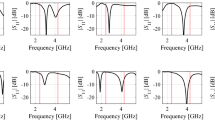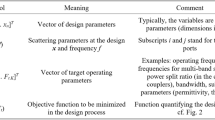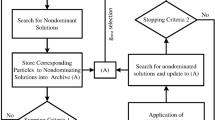Abstract
The knowledge-intensive radiofrequency circuit design and the scarce design automation support play against the increasingly stringent time-to-market demands. Optimization algorithms are starting to play a crucial role; however, their effectiveness is dramatically limited by the accuracy of the evaluation functions of objectives and constraints. Accurate performance evaluation of radiofrequency passive elements, e.g., inductors, is provided by electromagnetic simulators, but their computational cost makes their use within iterative optimization loops unaffordable. Surrogate modeling strategies, e.g., Kriging, support vector machines, artificial neural networks, etc., arise as a promising modeling alternative. However, their limited accuracy in this kind of applications has prevented a widespread use. In this paper, inductor performance properties are exploited to develop a two-step surrogate modeling strategy in order to evaluate the behavior of inductors with high efficiency and accuracy. An automated design flow for radiofrequency circuits using this surrogate modeling of passive components is presented. The methodology couples a circuit simulator with evolutionary computation algorithms such as particle swarm optimization, genetic algorithm or non-dominated sorting genetic algorithm (NSGA-II). This methodology ensures optimal performances within short computation times by avoiding electromagnetic simulations of inductors during the entire optimization process and using a surrogate model that has less than 1% error in inductance and quality factor when compared against electromagnetic simulations. Numerous real-life experiments of single-objective and multi-objective low-noise amplifier design demonstrate the accuracy and efficiency of the proposed strategies.













Similar content being viewed by others
References
Aho AV, Hopcroft JE (1974) The design and analysis of computer algorithms. Addison-Wesley Longman publishing Co, Boston
Alpaydin G, Balkir S, Dundar G (2003) An evolutionary approach to automatic synthesis of high-performance analog integrated circuits. IEEE Trans Evol Comput 7:240–252. https://doi.org/10.1109/TEVC.2003.808914
Ballicchia M, Orcioni S (2010) Design and modeling of optimum quality spiral inductors with regularization and Debye approximation. IEEE Trans Comput Aided Des Integr Circuits Syst 29:1669–1681. https://doi.org/10.1109/TCAD.2010.2061470
Deb K (2010) An efficient constraint handling method for genetic algorithms. Comput Methods Appl Mech Eng 186:311–338. https://doi.org/10.1016/S0045-7825(99)00389-8
Deb K, Pratap A, Agarwal S, Meyarivan T (2002) A fast and elitist multiobjective genetic algorithm: NSGA-II. IEEE Trans Evol Comput 6:182–197. https://doi.org/10.1109/4235.996017
Emmerich MTM, Giannakoglou KC, Naujoks B (2006) Single-and multiobjective evolutionary optimization assisted by Gaussian random field metamodels. IEEE Trans Evol Comput 10:421–439. https://doi.org/10.1109/TEVC.2005.859463
Fakhfakh M, Tlelo-Cuautle E, Siarry P (2005) Computational intelligence in analog and mixed-signal (AMS) and radio-frequency (RF) circuit design. Springer, Berlin
Glasserman P (2004) Monte Carlo methods in financial engineering. Springer, Berlin
González-Echevarría R, Castro-López R, Roca E, Fernández FV, Sieiro J, Vidal N, López-Villegas JM (2014) Automated generation of the optimal performance trade-offs of integrated inductors. IEEE Trans Comput Aided Des Integr Circuits Syst 33:1269–1273. https://doi.org/10.1109/TCAD.2014.2316092
Gorissen D, Tommasi LD, Hendrickx W, Croon J, Dhaene T (2008) RF circuit block modeling via Kriging surrogates. Paper presented at the 7th conference on microwaves, radar and wireless communications
Gorissen D, Couckuyt I, Demeester P, Dhaene T, Crombecq K (2010) A Surrogate modeling and adaptive sampling toolbox for computer based design. J Mach Learn Res 11:1051–2055
Jones DR, Schonlau M, Welch WJ (1998) Efficient global optimization of expensive black-box functions. J Glob Optim 13:455–492. https://doi.org/10.1023/A:1008306431147
Kennedy J, Eberhart R (1995) Particle swarm optimization. In: Proceedings of IEEE international conference on neural networks, Nov/Dec 1995, vol 1944, pp 1942–1948. https://doi.org/10.1109/ICNN.1995.488968
Khalesian M, Delavar MR (2016) Wireless sensors deployment optimization using a constrained Pareto-based multi-objective evolutionary approach. Eng Appl Artif Intell 53:126–139
Kleijnen JPC (2009) Kriging metamodeling in simulation: a review. Eur J Oper Res 192:707–716
Knowles J (2006) ParEGO: a hybrid algorithm with on-line landscape approximation for expensive multiobjective optimization problems. IEEE Trans Evol Comput 10:50–66. https://doi.org/10.1109/TEVC.2005.851274
Liu B, Zhao D, Reynaert P, Gielen GGE (2011) Synthesis of integrated passive components for high-frequency RF ICs based on evolutionary computation and machine learning techniques. IEEE Trans Comput Aided Des Integr Circuits Syst 30:1458–1468. https://doi.org/10.1109/TCAD.2011.2162067
Liu B, Gielen GE, Fernández FV (2014a) Automated design of analog and high-frequency circuits. Studies in computational intelligence. Springer, Berlin
Liu B, Zhao D, Reynaert P, Gielen GGE (2014b) GASPAD: a general and efficient mm-wave integrated circuit synthesis method based on surrogate model assisted evolutionary algorithm. IEEE Trans Comput Aided Des Integr Circuits Syst 33:169–182. https://doi.org/10.1109/TCAD.2013.2284109
Mandal SK, Sural S, Patra A (2008) ANN- and PSO-based synthesis of on-chip spiral inductors for RF ICs. IEEE Trans Comput Aided Des Integr Circuits Syst 27:188–192. https://doi.org/10.1109/TCAD.2007.907284
McKay MD, Beckman RJ, Conover WJ (2000) A comparison of three methods for selecting values of input variables in the analysis of output from a computer code. Technometrics 42:56–61
Mitchell M (1996) An introduction to genetic algorithms. MIT Press, Cambridge
Nieuwoudt A, Ragheb T, Massoud Y (2007a) Hierarchical optimization methodology for wideband low noise amplifiers. In: 2007 Asia and South Pacific design automation conference, 23–26 Jan 2007, pp 68–73. https://doi.org/10.1109/ASPDAC.2007.357794
Nieuwoudt A, Ragheb T, Massoud Y (2007b) Narrow-band low-noise amplifier synthesis for high-performance system-on-chip design. Microelectron J 38:1123–1134. https://doi.org/10.1016/j.mejo.2007.08.007
Okada K, Masu K (2010) Modeling of spiral inductors. In: Advanced microwave circuits and systems. InTech, Rijeka, pp 292–312
Paenke I, Branke J, Yaochu J (2006) Efficient search for robust solutions by means of evolutionary algorithms and fitness approximation. IEEE Trans Evol Comput 10:405–420. https://doi.org/10.1109/TEVC.2005.859465
Passos F et al (2015) Physical vs. surrogate models of passive RF devices. In: 2015 IEEE international symposium on circuits and systems (ISCAS), 24–27 May 2015, pp 117–120. https://doi.org/10.1109/ISCAS.2015.7168584
Patanè A, Santoro A, Conca P, Caparezza G, Magna AL, Romano V, Nicosia G (2016) Multi-objective optimization and analysis for the design space exploration of analog circuits and solar cells. Eng Appl Artif Intell. https://doi.org/10.1016/j.engappai.2016.08.010
Póvoa R, Bastos I, Lourenço N, Horta N (2016) Automatic synthesis of RF front-end blocks using multi-objective evolutionary techniques. Integr VLSI J 52:243–252
Pozar DM (2012) Microwave engineering, 4th edn. Wiley, New York
Ranter CD, Plas GVd, Steyaert MSJ, Gielen GGE, Sansen WMC (2002) CYCLONE: automated design and layout of RF LC-oscillators. IEEE Trans Comput Aided Des Integr Circuits Syst 21:1161–1170. https://doi.org/10.1109/TCAD.2002.802267
Shaeffer DK, Lee TH (1997) A 1.5-V, 1.5-GHz CMOS low noise amplifier. IEEE J Solid State Circuits 32:745–759. https://doi.org/10.1109/4.568846
Shayeghi H, Hashemi Y (2015) Application of fuzzy decision-making based on INSGA-II to designing PV-wind hybrid system. Eng Appl Artif Intell 45:1–17
Singhee A, Rutenbar RA (2010) Why quasi-monte carlo is better than monte carlo or latin hypercube sampling for statistical circuit analysis. IEEE Trans Comput Aided Des Integr Circuits Syst 29:1763–1776. https://doi.org/10.1109/TCAD.2010.2062750
Tulunay G, Balkir S (2008) A synthesis tool for CMOS RF low-noise amplifiers. IEEE Trans Comput Aided Des Integr Circuits Syst 27:977–982. https://doi.org/10.1109/TCAD.2008.917579
Vancorenland P, Ranter CD, Steyaert M, Gielen G (2000) Optimal RF design using smart evolutionary algorithms. In: Proceedings 37th design automation conference, 5–9 June 2000, pp 7–10. https://doi.org/10.1145/337292.337299
Xu Y, Hsiung KL, Li X, Pileggi LT, Boyd SP (2009) Regular analog/RF integrated circuits design using optimization with recourse including ellipsoidal uncertainty. IEEE Trans Comput Aided Des Integr Circuits Syst 28:623–637. https://doi.org/10.1109/TCAD.2009.2013996
Yue CP, Wong SS (2000) Physical modeling of spiral inductors on silicon. IEEE Trans Electron Devices 47:560–568. https://doi.org/10.1109/16.824729
Zhang Q, Liu W, Tsang E, Virginas B (2010) Expensive multiobjective optimization by MOEA/D with gaussian process model. IEEE Trans Evol Comput 14:456–474. https://doi.org/10.1109/TEVC.2009.2033671
Zitzler E, Thiele L (1999) Multiobjective evolutionary algorithms: a comparative case study and the strength Pareto approach. IEEE Trans Evol Comput 3:257–271. https://doi.org/10.1109/4235.797969
Web References
DACE toolbox. http://www.imm.dtu.dk/projects/dace. Accessed Feb 2017
Momentum ADS Momentum. http://www.keysight.com/en/pc-1887116/momentum-3d-planar-em-simulator?cc=ES&lc=eng. Accessed Feb 2017
Cadence Cadence SpectreRF circuit simulator. https://www.cadence.com/content/cadence-www/global/en_US/home/tools/custom-ic-analog-rf-design/circuit-simulation/spectre-rf-option.html. Accessed Feb 2017
Acknowledgements
This work was supported in part by the TEC2013-45638-C3-3-R and TEC2016-75151-C3-3-R Projects (funded by the Spanish Ministry of Economy, Industry and Competitiveness and ERDF) and in part by the P12-TIC-1481 Project (funded by Junta de Andalucia).
Author information
Authors and Affiliations
Corresponding author
Ethics declarations
Conflict of interest
All authors declare that they have no conflict of interest.
Human and animal participants
This article does not contain any studies with human participants or animals performed by any of the authors.
Additional information
Communicated by V. Loia.
Rights and permissions
About this article
Cite this article
Passos, F., González-Echevarría, R., Roca, E. et al. A two-step surrogate modeling strategy for single-objective and multi-objective optimization of radiofrequency circuits. Soft Comput 23, 4911–4925 (2019). https://doi.org/10.1007/s00500-018-3150-9
Published:
Issue Date:
DOI: https://doi.org/10.1007/s00500-018-3150-9




